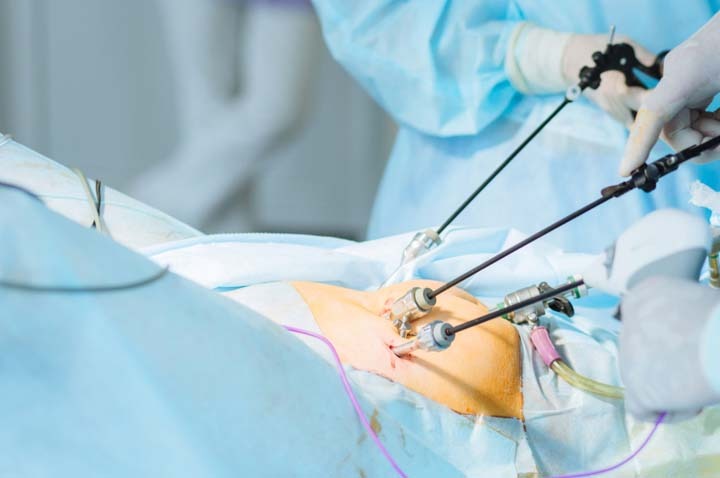


Most laparoscopies are performed in a day surgical center. The procedure is performed with a slender instrument called a laparoscope. The laparoscope is inserted through a small incision made inside the navel (about 1/4” wide). Carbon dioxide gas is introduced into the abdominal-pelvic cavity so that visualization of the uterus, ovaries, fallopian tubes and other pelvic organs is possible. The laparoscope has a small camera and light source on the end to allow the physician to see inside. Usually, a second instrument, such as a probe, is inserted through another small incision made just above the pubic bone. The probe helps the physician to gently move the pelvic organs for better visualization.
The surgery is generally completed in about one hour, and the instruments and laparoscope are removed. The carbon dioxide gas is allowed to escape, and the small incisions are sutured shut with a few small stitches. Patients awake from the general anesthesia, and are then monitored in the recovery room. They are discharged home on the same day.
Hysteroscopy can be helpful in the evaluation of infertility, recurrent miscarriage and abnormal uterine bleeding. Hysteroscopy is also used to examine the uterine cavity before women undergo in vitro fertilization. A slender instrument called a hysteroscope is inserted through the vagina and into the uterine cavity to look inside. Distending media is introduced into the cavity to allow visualization by the hysteroscope with a light source and camera.
The diagnostic hysteroscopy can be used to identify abnormalities in the uterus. Operative hysteroscopies are used to repair the uterine cavity so that it will provide a healthy environment for pregnancy.
Complications from these procedures are rare and seldom serious. Infections are possible and may require antibiotics before and/or after surgery. However, injury to the bladder, bowel, uterus or blood vessels is possible and should be discussed thoroughly with your doctor. In case of injury, a laparascopy or laparotomy (open surgery) may be required. Patients with previous multiple abdominal surgeries (especially bowel surgery), severe obesity or a history of pelvic adhesions may have increased risks.
If you have not done so already, discuss the procedure with your doctor thoroughly. A short office visit, just before the surgery, may be necessary to complete a pre-operative evaluation and review the consent forms.
Please call Fertility Associates of Memphis Monday through Friday from 8:00 am to 4:30 pm at 901-747-BABY (2229) to plan your procedure.
Most patients are discharged home within a few hours after surgery. Some patients will require medicine for pain and/or nausea for 24 hours. Most women will resume normal diet and activity within 48 hours. Anyone with severe pain, heavy bleeding, or high fever should contact the office. At night, our answering service will connect you to a nurse or physician. You may be scheduled for a postoperative visit one week after surgery.

